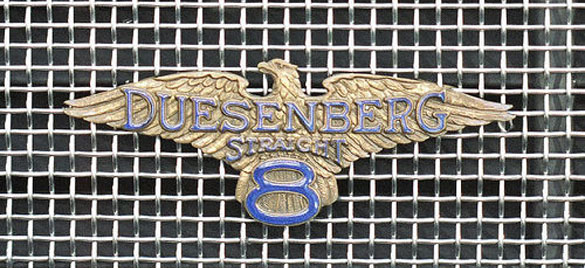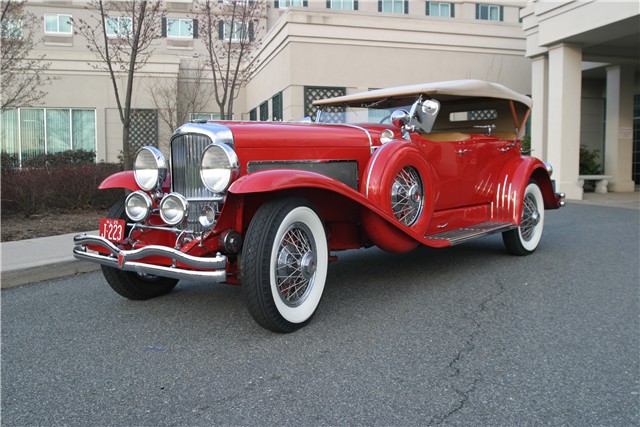




1935 Duesenberg SJ LA Grand Dual-Cowl Phaeton. The supercharged version, often referred to as "SJ", was reputed to do 104 miles per hour (167 km/h) in second and have a top speed of 135¨C140 mph (217¨C225 km/h) in third. Zero-to-60 mph (100 km/h) times of around eight seconds and 0-to-100 mph (160 km/h) times of 17 seconds were reported for the SJ in spite of the unsynchronized transmissions, at a time when even the best cars of the era were not likely to reach 100 mph (160 km/h). Duesenberg's generally weighed around two and a half tons; up to three tons was not unusual, considering the wide array of custom coachwork available.

1935 Clark Gable's Duesenberg JN. There is another version of the model J known as the Duesenberg JN (a name never used by the company either), all JN's were sold with Rollston coachwork and only 10 were produced in 1935.It was an attempt to give a more-modern look to an aging design, the JN was equipped with smaller 17-inch-diameter wheels (versus 19 inches), skirted fenders, bullet-shaped taillights, and bodies set on the frame rails for a lower look. The battery box and tool box were redesigned slightly so that the doors could close over the frame. Supercharged JNs gained the logical SJN designation.

Originally it was New York that supported the Model J. New York was the financial capital of the United States in 1929 and many of its people could afford such a very expensive car. But as the Depression deepened power shifted, and ultimately it was newly wealthy Hollywood that kept Duesenberg alive through much of the 1930s.It was so reputed and imposing that even though some Hollywood stars did not own a Duesenberg they posed next to the car to promote their careers.
Duesenberg advertising claimed it was the best car in the world, in their ads an elegant man or woman were seen together with a concise sentence; "He/She drives a Duesenberg", it did not mention its features and there was not even a picture of the automobile, they were so confident they almost never showed the car and the campaign was a success.
There was a gradual evolution (up to the 1937 model) to preserve the "stately lines" while moving into a more integrated mode of styling. The final evolution of the Duesenberg engine was ram-air intakes, which were added to some of the last supercharged models to produce 400 hp (298 kW), referred to as ¡°SSJ¡±. Of the 481 Model Js (including all its versions) produced between 1928 and 1937, about 378 are extant.

Model X Duesenberg's are very rare. According to Randy Ema, the top Duesenberg authority in the United States, only 13 were built. They fit in between the Duesenberg Model A and the famous J; only four are known to survive.
Duesenberg fell into oblivion during the Second World War and a few Model J's were sold for only $100 or $200, but about the middle of 1950s collectors began to get interested in vintage cars and to keep them.
After World War II, August Duesenberg tried to revive the Duesenberg name, but was unsuccessful; several later attempts were also unsuccessful. The closest came in the mid-1960s, with Fritz (Augusts' son) at the helm and Virgil Exner as the stylist, using the chassis of a 1966 Imperial and a Chrysler engine. One of Exner's Duesenberg designs was later produced as the modern Stutz Bearcat. A 1970s Duesenberg was also created, based on a Cadillac Fleetwood and with modern styling, although its production was not high.

The Duesenberg name still lives on as an object of opulence and luxury. It is estimated that as of 2006, approximately 50% (or roughly 600) of the originally manufactured Duesenberg's are still on the road as classic cars or "old-timers". Today, Duesenberg Model Js and SJs are among the most desired collectible classic cars in the world. It is not uncommon today for a Duesenberg in good condition to sell for over one million dollars, and a few sell for multimillion-dollar figures. At the Barrett-Jackson auction in January 2008, a Duesenberg J went for more than $1,000,000.Some of the World's most expensive Duesenberg's have been sold at auction by Dean Kruse including: Greta Garbo's J for $1,400,000 and a 1932 Duesenberg Murphy Disappearing Top for $1,700,000.
The origin of the American slang word "doozy" meaning something excellent or powerful, is either the Duesenberg's nickname, "Duesy", or an older term (derived from earlier slang, "daisy". In either case, reinforced by Duesenberg, an expensive, classy make of automobile, 1920s¨C30s.
